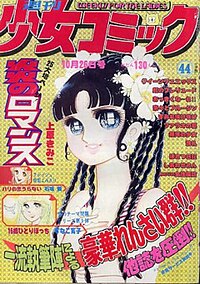Sho-Comi
 The cover of the October 26, 1975 issue of Shōjo Comic | |
| Categories | Shōjo manga |
|---|---|
| Frequency | Monthly (1968–1969) Semimonthly (1969–1970) Weekly (1970–1978) Semimonthly (1978– ) |
| Circulation | 197,273 (2008) |
| First issue | 1968 |
| Company | Shogakukan |
| Country | Japan |
| Language | Japanese |
| Website | http://www.sho-comi.com |
Shōjo Comic (少女コミック, commonly abbreviated to 少コミ Shōkomi, Sho-Comi or Shōcomi) is a shōjo manga magazine published twice monthly in Japan by Shogakukan since 1968. It was originally published weekly and it continued to be published weekly until the 1980s. Many influential shōjo manga ran in Shōjo Comic during the 70s. Moto Hagio's works and Keiko Takemiya's works in particular were very groundbreaking. [citation needed]
The manga it features is marketed to appeal to girls from late middle school through high school. Originally the manga in Shōjo Comic were very tame, and rarely featured anything that could be considered sexual in content, not even kissing scenes. Over time, with successful stories such as Mayu Shinjo's series Kaikan Phrase (Sensual Phrase), which was heavy in sexual content, Shōjo Comic is now seen as having more sexual content than its competitors Margaret and Hana to Yume.
The manga series from this magazine are later compiled and published in book form (tankōbon) under the Flower Comics imprint.
Manga artists and series featured in Shōjo Comic
- Mitsuru Adachi
- Kotomi Aoki
- Moto Hagio
- Mann Izawa (story) and Yumiko Igarashi (art)
- Gō Ikeyamada
- Shotaro Ishinomori
- Cyborg 009 (5th version, 1975–1976)
- Miyuki Kitagawa
- Kanan Minami
- Kaho Miyasaka
- Aqua Mizuto
- Iori Shigano
- Mayu Shinjo
- Kaikan Phrase
- Love Celeb
- Ai wo Utau yori Ore ni Oborero! (Blaue Rosen)
- Chie Shinohara
- Ao no Fūin Blue Seal
- Red River Sora wa Akai Kawa no Hotori
- Akatsuki no Lion Safaktaki Aslan
- Keiko Takemiya
- Masami Takeuchi
- Yuu Watase
- Rie Takada
- Kozue Chiba
Related magazines
Reception
In 2007, the Japanese National PTA Conference ranked Sho-Comi the #1 worst comic magazine for young children due to its excessive sexual content.[1] Many concerned parents have advised publishers to be more wary of the availability of these magazines to young readers.[2] According to the Japan Magazine Publishers Association, research conducted in 2005 revealed that 26% of Sho-Comi's readers were below the age of 13.[3]
References
- ^ "Sho-Comi the Worst Shojo Manga Magazine for Children According to Japanese Parents". ComiPress. 2007-05-17. Retrieved 2009-02-18.
- ^ "On Modern Shoujo Manga and Sex: Excessive Sexual Material in Shoujo Manga and Magazine". ComiPress. 2006-11-30. Retrieved 2009-02-18.
- ^ "A History of Shojo, Loli, and Harmful Books". ComiPress. 2007-07-17. Retrieved 2009-02-18. [dead link]
External links
- ShoComi Official Website
